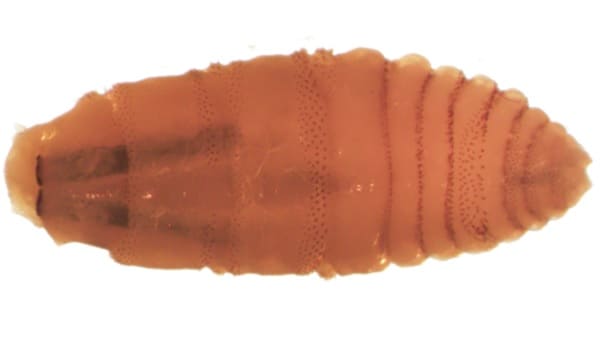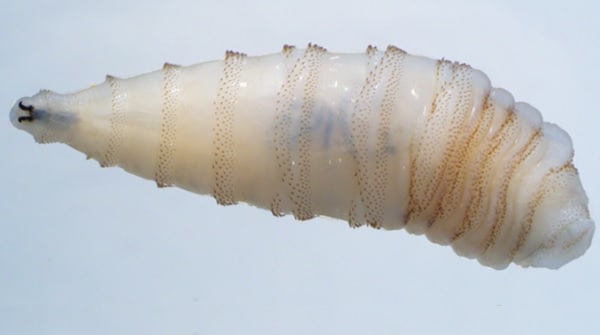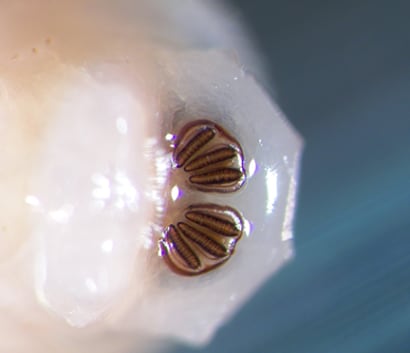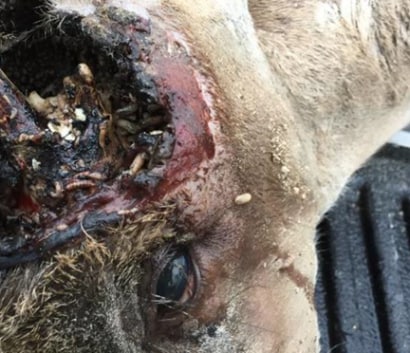Key points
- New World screwworm (NWS) myiasis is typically a disease of livestock but can also affect humans. Countries in Central America where NWS was previously controlled are reporting an increase in animal and human cases.
- NWS is endemic in South America and the Caribbean.
- NWS occurs in people with open wounds; it can also occur in other body cavities with mucus membranes (e.g., nasal passages).
- There is no medication to treat NWS; prevention and quick removal are key.
- Healthcare providers should remove the NWS larvae from the affected site.
- Kill and preserve the larvae by placing it directly into concentrated (70%) ethyl or isopropyl alcohol.
- Send all suspected NWS specimens to CDC for identification and diagnosis.

Cause
New World screwworm (NWS) infestation is a type of myiasis that occurs when NWS fly larvae (Cochliomyia hominivorax) infest the living flesh of warm-blooded animals—most commonly livestock and less commonly birds, pets, and humans. The screwworm flies are attracted to and lay their eggs on and in open wounds and mucous membranes.
The name screwworm refers to the feeding behavior of the larvae (maggots) as they burrow (screw) into healthy tissue. NWS larvae cause extensive damage by tearing into the host's tissue with sharp mouth hooks. The wound can become larger and deeper as more larvae hatch and feed on living tissue. As a result, NWS can cause serious damage to the animal or person it infects. Bacterial superinfection can also occur because of the NWS infestation.
Risk factors
NWS is endemic in the American tropics and subtropics which includes the countries of South America, Cuba, Haiti, and the Dominican Republic. There have been recent cases in Central American countries for the first time in many years.
People at higher risk include
- Those living in rural areas in regions or countries where NWS is endemic, and where livestock are raised.
- People who frequently work with livestock.
- Anyone with open sores or wounds, including from a recent surgery, as the flies will lay eggs on open sores.
- Vulnerable populations, including people who are immunocompromised, those at extremes of age, and people experiencing malnutrition.
How it spreads
New World screwworm infestations begin when a female fly lays eggs on a wound or orifice of a live, warm-blooded animal. The odor of a wound or an opening such as the nasal or eye openings, umbilicus of a newborn, or genitalia attracts female flies. Wounds as small as a tick bite may attract a female fly to feed. One female can lay 200 – 300 eggs at a time and may lay up to 3,000 eggs during her 10- to 30-day lifespan.
Eggs hatch into larvae that burrow into the wound to feed on the living flesh. After about 7 days of feeding, larvae drop to the ground, burrow into the soil, and pupate. The adult screwworm fly emerges from the soil after 7 – 54 days depending on temperature and humidity. Female flies mate only once in their lifespan.
Resource
Clinical features
How to spot an infestation
- Screwworm infestations are very painful.
- Secondary infection may occur in an NWS-infested wound.
- Larvae may be visible in open wounds, surgical sites, or mucus membranes in people who are experiencing an NWS infestation. Wounds as small as tick bites can attract flies.
- Egg masses may be around or in the wound; larvae may be visible by the third day of infestation.
- Because they feed on live flesh, NWS larvae may burrow deep into wounds or openings. This is different from other species of maggots that may appear around the outer surface of the wound.
Prevention
The best way to prevent New World Screwworm (NWS) is to avoid exposure. Healthcare providers should
- Be alert for NWS symptoms in people with a history of recent travel to regions where NWS is endemic.
- Encourage patients to avoid spending time around livestock or where livestock are housed while in rural areas in NWS endemic regions.
- Advise patients to clean and cover wounds, wear loose-fitting, long-sleeved shirts and pants and socks, and use Environmental Protection Agency (EPA)-registered insect repellents.
- Advise patients to avoid sleeping outdoors and protect sleeping quarters with screens or bed nets, especially where people have wounds or active nasal or ocular discharges. Screening of hospital windows and doors is essential.
Testing
Clinicians can diagnose NWS by finding fly larvae (maggots) in tissue. Identification of the genus or species involves comparing certain morphological structures on the larvae, including the anterior and posterior spiracles, mouthparts, cephalopharyngeal skeleton, and cuticular spines. Travel history can also be helpful for genus or species-level identification.
Please contact dpdx@cdc.gov for laboratory testing inquiries and instructions for telediagnosis image submissions and physical specimen submissions. Direct clinical inquiries and patient management related questions to parasites@cdc.gov.
Warning—the gallery contains images of NWS myiasis in animals that some people may find disturbing.

|

|

|

|

|

|
Treatment
The only way to treat NWS is to physically remove the larvae from the infested tissue. All suspected NWS larvae should be collected and placed into a leak-proof container with 70% ethanol. The volume should be sufficient to fully submerge larvae, which will kill and preserve them for confirmatory diagnostic examination. If 70% (or greater) ethanol is unavailable, 70% (or greater) isopropanol or 5 – 10% formalin are acceptable alternatives, although not preferred.
There are anecdotal reports of using ivermectin in off-label treatment of NWS infestations in humans. However, there are no controlled, double-blind studies measuring the impact of ivermectin use on myasis.
Reporting
- Report both human and animal infestations immediately. Human infestations can be an indication of infestations in animals.
- If you think your patient has NWS, report it immediately to your local or state health department.
- Veterinarians should report any suspicious cases immediately to their state animal health official and APHIS office.
Resources
- New World screwworm - USDA
- New World screwworm: What You Need to Know (English and Spanish)
- New World screwworm Story Map
- Screwworm: An International Threat to Human and Animal Health
